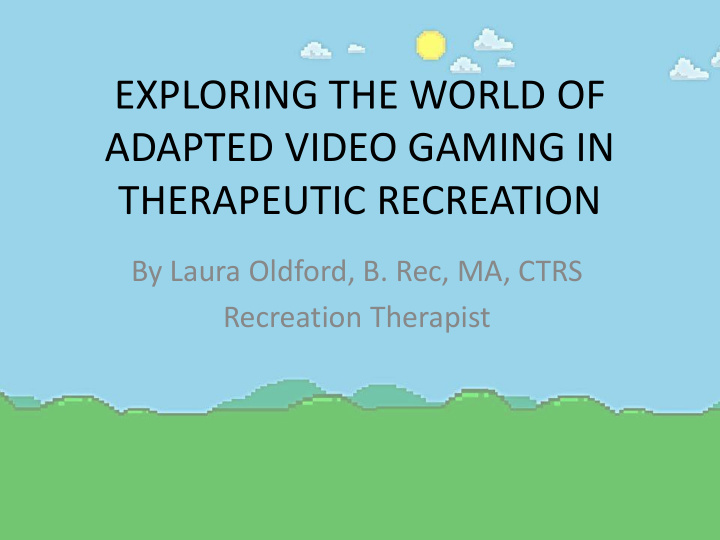



EXPLORING THE WORLD OF ADAPTED VIDEO GAMING IN THERAPEUTIC RECREATION By Laura Oldford, B. Rec, MA, CTRS Recreation Therapist
TABLE OF CONTENTS • Who am I • Adapted Video Gaming • The benefits of adapted gaming • Acknowledging the ‘negative’ research – People with disabilities and participation – The impact of a lack of participation • Integrating into TR practice – Breaching the participation gap • Evaluation & Research – Quality of Life and negative views
WHO AM I? • Laura Oldford, B. Rec, MA, CTRS • Stan Cassidy Centre for Rehabilitation • Adult & Pediatrics • Research: Quality of Life, individual experience, clinical best practices, patient perspectives • Leisure: not video games!
VIDEO GAMING • Definition • Who plays?
Contraindications/Limitations • Society & screen time
Contraindications/Limitations • Journal of the Canadian Pediatric Society • Active Healthy Kids Canada’s Position on Active Video Games for Children and Youth In light of the available evidence, AHKC does not recommend AVGs as a strategy to help children be more physically active. However, AVGs may exchange some sedentary time for light- to moderate-intensity physical activity, and there may be specific situations in which AVGs provide benefit (eg, motor skill development in special populations and rehabilitation).
But… there is a gap • Role of adapted with individuals with physical disabilities – limited access to other recreation participation opportunities • Research exists on: – Subjective well-being – Quality of life – Social impacts – Other barriers
The Benefits “I believe that there is nothing more powerful for people with disabilities than the freedom that only video games can provide. It’s an art form that allows us all to run, jump, and be whatever we want to be.” - Mark Barlet, AbleGamers
Benefits QUALITY OF LIFE THERAPEUTIC MODALITY • Hanging out with • Postural control friends/family • Turn taking • Levels the playing • Losing with grace, field • Fine motor • Success coordination • Socialization • Hand eye coordination • Having fun! • Breath support • Socialization
SOCIAL BENEFITS OF GAMING? • Gaming has been stereotyped to happen in social isolation (Granic et al., 2014, p. 72). • New opportunities – Individual – Multi player Competitive – Multi player Cooperative – Online • Chat/voice overs • How can patients get involved?
Adapted Video Gaming
Practical Applications • How to bring into your TR practice – 3 pieces to success – Activity Analysis – Continuum of abilities and interests – Interdisciplinary approach/perspective – Evaluation
Practical Applications 3 Pieces of Success Interests abilities game requirements
Wii Activity Analysis Game Title: Date: Completed by: PHYSICAL ASPECTS: 1. What type of gross motor movement is required? One hand (main controller) Two hands (controller & nunchuck) No movement Body Movement Large Range Minimum Range 2. Does the movement need to be quick or slow? Quick (timed reaction) Slow (times reaction) Quick (no timing) Slow (no timing) 3. Does the movement need to be precise or gross? Precise (fine motor) Gross 4. What buttons need to be pressed? B A Z C Left Arrow Right arrow Up Arrow Down Arrow None 1 2 5. Are the buttons mandatory to be successful in the game? Yes No 6. Do buttons need to be pressed simultaneously in the game? Yes No If yes, which buttons? __________________ COGNITIVE ASPECTS: 1. How many steps are required in the activity? Few 1 3 5 Many 2. How complex are the steps to understand? Simple 1 3 5 Complex 3. What degree of strategy is required in the activity? Simple 1 3 5 Complex 4. What degree of short term memory is required in the activity? Little 1 3 5 Much 5. Can success in questions 1-4 be achieved through verbal cueing? Yes No
SOCIAL ASPECTS: 1. What is the primary interaction pattern required in the activity? Extraindividual (One player game- no interaction with others required) Interindividual (Two-player game- competitive) Multilateral (Multi-player- competitive) Intragroup (Multi-player- cooperative) 2. How much physical proximity is required by the activity? Distant 1 3 5 Close 3. What degree of verbal communication is required by the activity? Little 1 3 5 Much 4. What degree of noise is generated by the activity? Silent 1 3 5 Loud 5. What age group is appropriate for this game? Children (11 & under) Adolescents (12-18) Young adults (18-30) Adults (30-55) Older Adults (55-70) Seniors (70+) 6. When the game is finished, does the system inform the user if they have won or lost? Yes No 7. If yes, is this done in a constructive way? Yes No Is there anything else you would like to add about this game that would be important to note? ________________________________________________________________ ________________________________________________________________ ________________________________________________________________ ________________________________________________________________ ________________________________________________________________ ________________________________________________________________
Practical Applications Physical & Physical Cognitive Cognitive disability Disabilities Disabilities
Evaluation & Research • Best practice – From various journals, mostly qualitative or case studies – Many recommend for future: • Evaluating quality of life • Exploring specifics for persons with disabilities – Best as individualized treatment plans to target interests, abilities, and specific goals
Evaluation & Research • Game Changers- adapted video game program – TR, OT, Rehab Engineering – QOL Focus for patients with very limited physical abilities – How can we measure? • Mixed methods, QOL standardized measure with an interview guide • Mixed within clinical program • Evaluated after 5 participates
Conclusions • New and innovative opportunity • Limited research on persons with disabilities and video games • Potential for – Social Impact – Quality of life impact • Be cognizant to deliver therapeutic programs and opportunities that meet – Interests & abilities
Questions??
Recommend
More recommend